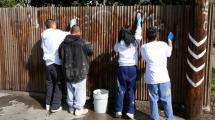Youth who receive special education services under the Individuals with Disabilities Education Act (IDEA 2004) and especially young adults of transition age, should be involved in planning for life after high school as early as possible and no later than age 16. Transition services should stem from the individual youth’s needs and strengths, ensuring that planning takes into account his or her interests, preferences, and desires for the future.
Recovery and Reunification
Recovering from a disaster takes time and is a gradual process. The National Disaster Recovery Framework (PDF, 116) provides nationwide guidance and supports States, Tribes, and local jurisdictions with recovery efforts through a flexible structure that encourages a unified and collaborative approach. Key aspects of recovery efforts for youth include reunification with their families, safety, and emotional and physical well-being, among others.
Reunification
Reuniting families after disasters is often one of the most challenging processes to plan for, implement, and accomplish.1 For example, more than 5,000 children were separated from their families for as long as six months after Hurricanes Katrina and Rita.2 Substantial federal efforts have taken place in order to support reunification. Being aware of these efforts can help youth-serving agencies to assist with reunification efforts in their communities following disasters.
In January 2012 a national initiative was created to support an agreement that was executed between FEMA and the National Center for Missing and Exploited Children (NCMEC) that helps them work more closely together to address disaster response. The goal of the national initiative is to ensure quick reunification of youth and their families as the result of a disaster. The development team included federal, state, and non-governmental organizations and aims to accomplish the following:
- Assist local and state governments in determining processes, communication lines, and the identification of roles and responsibilities necessary to facilitate the expeditious reunification of youth separated as a result of disaster
- Encourage stakeholders and community leaders to develop and build upon existent relationships prior to a disaster
- Establish an understanding of how all responsible parties (leading and supporting) can work together to support each other’s missions
- Identify tools and resources that could assist localities and states in disaster-related reunification efforts (i.e., tracking & reunification systems)
FEMA’s National Emergency Family Registry and Locator System (NEFRLS) is an online, secure system that helps family reunification when individuals are separated during a disaster. It provides a platform for survivors and their loved ones to communicate their location as well as provide a personalized message. A call center is also available to assist people who do not have Internet access.
In conjunction with the NEFRLS, the National Emergency Child Locator Center (NECLC) is operated by the National Center for Missing & Exploited Children and activated during Presidentially-declared disasters. Its mission is to help locate displaced children and reunite them with their families. In February 2007, FEMA signed a Memorandum of Understanding with the NCMEC, the American Red Cross, the U.S. Department of Justice, and the U.S. Department of Health and Human Services to enhance information-sharing concerning people displaced by disasters.
To support the reunification of children under 21 years of age with their parent(s)/legal guardian, FEMA works in collaboration with the NCMEC. Individuals reporting or searching for a child missing as a result of a disaster should call the NCMEC National Emergency Child Locator Center at 1-866-908-9572. NCMEC is staffed 24-hours a day.
Additionally, the American Red Cross maintains Safe and Well, a web-based system that helps reunify friends and family displaced by a disaster.
Safety and Physical Well-Being
One of the first steps of recovery is ensuring that youth are safe and that any injuries and physical needs that resulted from the disaster are addressed through first aid and medical attention. Disasters also create additional hazards that can remain even while communities recover. These hazards can cause injury or illness and may include washed out roads, downed power lines, contaminated buildings, stray animals, contaminated water, gas leaks, broken glass, damaged electrical wiring, and slippery floors. It is important to ensure youth are aware of the dangers of these situations and the local authorities are informed of any identified hazards.
The Centers for Disease Control and Prevention (CDC) provides a number of tip sheets to help families and communities address potential safety concerns as a result of disasters. These include the following:
- Preventing illness and injury
- Ensuring your food and water is safe
- Returning home and cleaning up safely
- Protecting you and your family from animals and insects
- Preventing carbon monoxide poisoning
- Protecting you and your family form mold
- Knowing what to do when the power goes out
Emotional Well-Being and Coping
Regardless of age, all individuals who experience a disaster are affected in some way and it will take time to return to normal. Youth’s reactions to disasters have been found to differ as a result of age, but may include being scared, helpless, confused, or insecure. These feelings may lead to anger, anxiety, aggression, and participation in risky behaviors.
Families and adults are instrumental in helping youth to cope with disasters. Youth’s reactions to disasters often reflect the response of their parents and adults.3 Researchers found that family cohesion was a mitigating factor in helping youth process and recover from traumatic experiences and that family and community support can act as protective factors for youth and enhance resiliency.4 Therefore, parents can help youth to cope by modeling coping and providing calm and confident reactions even when they may be stressed. If they are unable to control their emotions it may be important for them to seek outside help and support from family or professionals. Adults can help youth to understand their response and reactions to disasters. The Centers for Disease Control and Prevention provides information directed at parents and caregivers, middle school students, and high school students to help them maintain a healthy state of mind and recognize their responses to disasters, and encourages adults to talk with their children about their feelings and experiences.
Recovering from disasters takes time and there is no magic cure, but both adults and youth can take steps to feel better in response to disasters by:
- following a normal routine as much as possible;
- eating healthy meals and being careful not to skip meals or overeat;
- exercising and staying active;
- helping other people in the community as a volunteer;
- staying busy;
- accepting help from family, friends, co-workers, or clergy;
- talking about your feelings; and
- limiting time focused on the sights and sounds of what happened by not dwelling on TV, radio, or newspaper reports on the tragedy.5
While many youth are able to cope with their feelings after a period of time, some disasters can cause ongoing psychological distress. Risk factors for psychological distress include:
- Direct exposure to the disaster, such as being evacuated, observing injuries or death of others, or experiencing injury along with fearing one’s life is in danger.
- Loss/grief related to the death or serious injury of family or friends.
- Ongoing stress from the secondary effects of disaster, such as temporarily living elsewhere, loss of friends and social networks, loss of personal property, parental unemployment, and costs incurred during recovery to return the family to pre-disaster life and living conditions.6
These risk factors can be exacerbated by reminders of the disaster, previous experiences with disasters or traumatic events, and pre-existing mental health and anxiety conditions and disorders.7 In a study looking at the aftereffects of Hurricane Katrina, almost half the youth surveyed met the criteria for mental health services within the first year after the hurricane and 41 percent continued to meet the criteria for mental health services in the second year after the hurricane.8 Further, findings indicated that young women who had family or friends who were killed, had belongings destroyed, lived in a shelter, or experienced previous trauma showed increased trauma symptoms. In addition, youth in fourth through sixth grade showed significantly more mental health symptoms than their older peers.9
For youth and adults experiencing distress and ongoing effects of disasters it is important to reach out for help. The Disaster Distress Helpline (DDH) is the nation’s first hotline dedicated to providing disaster crisis counseling. The toll-free Helpline operates 24 hours-a-day, seven days a week. This free, confidential and multilingual, crisis support service is available via telephone (1-800-985-5990) and SMS (Text ‘TalkWithUs’ to 66746) to U.S. residents who are experiencing psychological distress as a result of a natural or man-made disaster, incidents of mass violence or any other disasters. Callers are connected to trained and caring professionals from the closest crisis counseling center in the network. The helpline staff provides confidential counseling, referrals, and other needed support services.
Managing mental health services to address the trauma and mental health needs of youth is an ongoing process throughout a youth’s recovery and varies based on the severity of need. The Administration for Children and Families offers a range of information and resources on Mental Health Services in Disasters and Major Disruptions and the Substance Abuse and Mental Health Services Administration provides additional resources and technical assistance to support disaster recovery as it relates to mental and behavioral health.
Resources
Centers for Disease Control and Prevention: Coping With a Disaster or Traumatic Event
The effects of a disaster, terrorist attack, or other public health emergency can be long-lasting, and the resulting trauma can reverberate even with those not directly affected by the disaster. This page provides general strategies for promoting mental health and resilience that were developed by various organizations based on experiences in prior disasters.
Recovering from Disasters and Other Disruptions
After disasters and other breaks in continuity of services, child welfare agencies' tasks are continuing to manage, capturing lessons learned, and rebuilding better systems. In this section you will find federal and state resources for longer term recovery and rebuilding from natural disasters or other major unexpected events, including resources on mental health services and research.
Disaster Assistance: Moving Forward
After the disaster is over, much of your life may need to be rebuilt, like dealing with home damage, replacing personal property and finding important documents. Here are some resources to help you get started.
Disaster Technical Assistance Center (DTAC)
Established by the Substance Abuse and Mental Health Services Administration (SAMHSA), the Disaster Technical Assistance Center supports SAMHSA's efforts to prepare states, territories, Tribes, and local entities to deliver an effective mental health and substance abuse (behavioral health) response to disasters.
Tips for Talking to Children and Youth after Traumatic Events: A Guide for Parents and Educators (PDF, 4 pages)
This fact sheet helps teachers recognize and address problems in children and teens affected by trauma after an act of violence. It describes signs of stress reactions that are common in young trauma survivors at different ages and offers tips on how to help.
Psychosocial Issues for Children and Adolescents in Disasters
This booklet offers resources for those working with children in the wake of disaster. It discusses theories of child development as applied to a youth experiencing the fear, anxiety, and trauma of disaster and offers practical suggestions, case studies, and a resource guide.
Children and Youth—SAMHSA Disaster Behavioral Health Information Series installment
This SAMHSA Disaster Behavioral Health Information Series installment from the Disaster Technical Assistance Center (DTAC) focuses on the reactions and mental health needs of children and youth after a disaster and contains resources from both the child trauma and disaster behavioral health fields. The collection includes an annotated bibliography and a section with helpful links to organizations, agencies, and other resources that address disaster preparedness and response issues surrounding children and youth.
Cultural Awareness: Children and Youth in Disasters Podcast
The goal of this 60-minute podcast from the Disaster Technical Assistance Center (DTAC) is to assist disaster behavioral health responders in providing culturally aware and appropriate disaster behavioral health services for children, youth, and families impacted by natural and human-caused disasters. Featured speakers include April Naturale, Ph.D., of SAMHSA DTAC and Russell T. Jones, Ph.D., of Virginia Tech University. Listen to the podcast and view the presentation.
Parent and Teacher Guidelines for Helping Children after Hurricanes
Children's reactions to a hurricane and its aftermath are strongly influenced by how their parents, teachers, and other caregivers cope during and after the storm. They often turn to these adults for information, comfort, and help. There are many reactions to hurricanes and other frightening events that are common among children. These generally diminish with time, but knowing that these reactions are likely—and normal—can help parents and teachers to be prepared. The National Child Traumatic Stress Network has developed guidelines for parents (PDF, 3 pages) and teachers (PDF, 3 pages). The guidelines for parents are also available in Spanish, Guia para los padres para ayudar a los niños despues de un huraca (PDF, 3 pages).
After the Hurricane: Helping Young Children Heal (PDF, 1 page)
Young children, toddlers, and preschoolers—even babies—know when bad things happen, and they remember what they have been through. Here are some ways you can help them. This tip sheet was prepared by the Child Trauma Research Project of the University of California San Francisco, part of the Early Trauma Treatment Network.
Helping Young Children and Families Cope with Trauma (PDF, 8 pages)
This document from the National Child Traumatic Stress Network informs parents of common reactions or symptoms children may have following a traumatic event. It tells parents how to listen to their children and how to help them feel safe. This document addresses self-care and support for parents as well. This resource is also available in Spanish, Ayudando a Niños(as) y Familias a Enfrentarse con el Trauma (PDF, 8 pages).
Childhood Traumatic Grief Educational Materials for Parents
The information from the National Child Traumatic Stress Network provides an overview of childhood traumatic grief, its general signs and symptoms, and some suggestions on what parents can do to help their child. Using this guide can be a first step for parents to help them understand their child's experience of intense grief following a death of a loved one that the child experienced as being especially difficult or traumatic.
Trinka and Sam Children's Booklet (PDF, 20 pages)
From the National Child Traumatic Stress Network, Trinka and Sam: The Rainy Windy Day is a story developed to help young children and their families begin to talk about feelings and worries they may have after they have experienced a hurricane. In the story, Trinka and Sam, two small mice, become scared and worried when it begins to rain and storm. The rain and wind remind them of the hurricane they experienced before. The story describes some of their reactions and talks about how their parents help them to express their feelings and feel safer. In the back of the booklet, there is a parent guide that suggests ways that parents can use the story with their children. The booklet can also be viewed in Spanish, Trinka y Juan en un día de mucho viento y lluvia (PDF, 21 pages).
Recovery: After a Flood
Children react differently to a flood and its aftermath depending on their age, developmental level, and prior experiences. Some will respond by withdrawing, while others will have angry outbursts. Still others will become agitated or irritable. Parents should attempt to remain sensitive to each child's reactions.
Recovery: After a Hurricane
After a hurricane most families can be expected to recover over time, particularly with the support of family, friends, and organizations. The length of recovery will depend upon how frightening the hurricane was, if evacuation from home was necessary, and the extent of the damage and loss. Children's functioning will be influenced by how their parents and other caregivers cope during and after the hurricane. This webpage from the National Child Traumatic Stress Network provides information about recovering from a hurricane.
Psychological First Aid
Psychological First Aid (PFA) is an evidence-informed approach for assisting children, adolescents, adults, and families in the aftermath of disaster and terrorism. The National Child Traumatic Stress Network and the National Center for PTSD are pleased to make the Second Edition of Psychological First Aid Field Operations Guide and accompanying handouts available. In addition to the English-language edition of PFA, there are versions in Spanish, Japanese, and Chinese.
The Unaccompanied Minors Registry (UMR)
The Unaccompanied Minors Registry (UMR) will be administered by the NCMEC and supported by FEMA. It will be available during all disasters to gather and share information with local law enforcement and assist in the reunification of displaced children with their families or legal guardians. The UMR will allow for a more expedient and efficient reunification of unaccompanied minors with their families and legal guardians when separated by a disaster and supports the ability to collect, store, report, and act on information related to children missing or lost as a result of a disaster. The UMR will roll out in Fall 2012 and information can be found at the NCMEC website.
The Readiness and Emergency Management for Schools (REMS) Technical Assistance Center
The REMS Technical Assistance Center supports public and non-public schools, school districts, and institutions of higher education in school emergency management, including the development and implementation of comprehensive all-hazards emergency management plans. The TA Center disseminates information about school emergency management to help individual schools, school districts, and institutions of higher education learn more about developing, implementing, and evaluating comprehensive, all-hazards school emergency management plans.
For more information about reunification and recovery available through the REMS TA Center, please visit the REMS TA Center’s website. For more information about psychological and emotional recovery and support available through the REMS TA Center, please visit Emergency Management for Schools Training, Recovery – Mental Health.
DisasterAssistance.gov
This site consolidates disaster assistance information in one place. The secure, user-friendly U.S. Government web portal allows users to apply for assistance online following a presidentially declared disaster and to find additional resources and information about recovering from a disaster.
American Red Cross and FEMA: Helping Children Cope with Disaster (PDF, 12 pages)
This booklet was created to assist parents and caregivers in helping youth cope with disasters and emergencies. The guide also provides information on preparing family emergency plans and discussing these plans with youth.
FEMA Disaster Survivor Assistance
This section of the FEMA website provides information and resources for recovering from disasters. It includes information focused on coping with disaster, providing assistance, and reunifying family and friends.
Department of Homeland Security Response and Recovery
This Department of Homeland Security website provides information and resources focused on disaster response and recovery. Additional information about the ways the Department of Homeland Security can help with recovery is available on the disaster assistance page.
National Disaster Recovery Framework (PDF, 116 pages)
This document describes the national approach to disaster recovery that focuses on unity and collaboration. The core principles of the approach include individual and family empowerment, leadership and local primacy, pre-disaster recovery planning, partnerships and inclusiveness, public information, unity of effort, timeliness and flexibility, resilience and sustainability, and psychological and emotional recovery.
1 Nager, 2009
2 National Center for Missing & Exploited Children, 2006
3Silverman & La Greca, 2002
4 Loar, Wolmer, and Cohen, 2001; Osofsky et al., 2009
5 Centers for Disease Control and Prevention, 2009
6 FEMA and the American Red Cross, 2004
7 Pfefferbaum et al., 2008; Osofsky et al., 2009
8 Osofsky et al., 2009
9 Osofsky et al., 2009
Youth Briefs
Research links early leadership with increased self-efficacy and suggests that leadership can help youth to develop decision making and interpersonal skills that support successes in the workforce and adulthood. In addition, young leaders tend to be more involved in their communities, and have lower dropout rates than their peers. Youth leaders also show considerable benefits for their communities, providing valuable insight into the needs and interests of young people
Statistics reflecting the number of youth suffering from mental health, substance abuse, and co-occurring disorders highlight the necessity for schools, families, support staff, and communities to work together to develop targeted, coordinated, and comprehensive transition plans for young people with a history of mental health needs and/or substance abuse.
Nearly 30,000 youth aged out of foster care in Fiscal Year 2009, which represents nine percent of the young people involved in the foster care system that year. This transition can be challenging for youth, especially youth who have grown up in the child welfare system.
Research has demonstrated that as many as one in five children/youth have a diagnosable mental health disorder. Read about how coordination between public service agencies can improve treatment for these youth.
Civic engagement has the potential to empower young adults, increase their self-determination, and give them the skills and self-confidence they need to enter the workforce. Read about one youth’s experience in AmeriCorps National Civilian Community Corps (NCCC).






